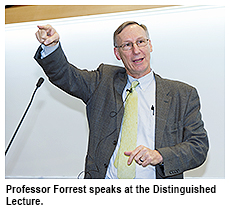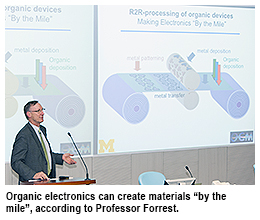Making small things big in the world of organic electronics
Michael Gibb
?
The first City University of Hong Kong Distinguished Lecture of 2015 was delivered by Professor Stephen Forrest of the University of Michigan on the topic of “Making Small Things Big in the World of Organic Electronics”.
In the talk, the speaker assessed several important demonstrations of organic electronic devices that span a range of dimensions, and then proceeded to theorise about the future of this rapidly emerging global industry.
“Organic electronics occupies a truly scalable world,” said Professor Forrest who works in the Departments of Electrical Engineering and Computer Science, Physics and Materials Science and Engineering at the University of Michigan.
Professor Forrest pointed out to the audience that even when he was starting out as a junior faculty member his colleagues were speculating that Moore’s Law, which states that the number of transistors in an integrated circuit will double approximately every two years, would soon become redundant. However, Moore’s Law has held true, according to data that Professor Forrest presented.
What interests Professor Forrest is that as devices get smaller, the potential to “make things bigger” was now available.
“Phenomena at the quantum level can provide solutions to applications as large as wall-mounted displays and lighting, to solar cells that cover the sides of buildings, to flexible electronic circuits that can mimic the eye and ‘see around corners’,” he said.
Using newspaper presses as an illustration, he foresaw the possibility of printing literally "kilometres" of circuits as if they were newsprint, which would provide new and exciting challenges to the device physicist, applications engineer, and specialist in advanced manufacturing, he said.
Professor Forrest even suggested the possibility of a similar law to Moore's Law, which focused on making cheap materials through organic electronics, positing that an area can grow by three-fold every two years.
“Organic electronics can make things ‘by the mile’, not by the inch,” he said.
Professor Forrest is an expert in the area of organic electronics. He received the Jan Rajchman Prize from the Society for Information Display for invention of phosphorescent OLEDs in 2006, and is the recipient of the 2007 IEEE Daniel Nobel Award for innovations in OLEDs. Professor Forrest was honoured by Princeton University with the establishment of the Stephen R. Forrest Endowed Faculty Chair in Electrical Engineering in 2012.

